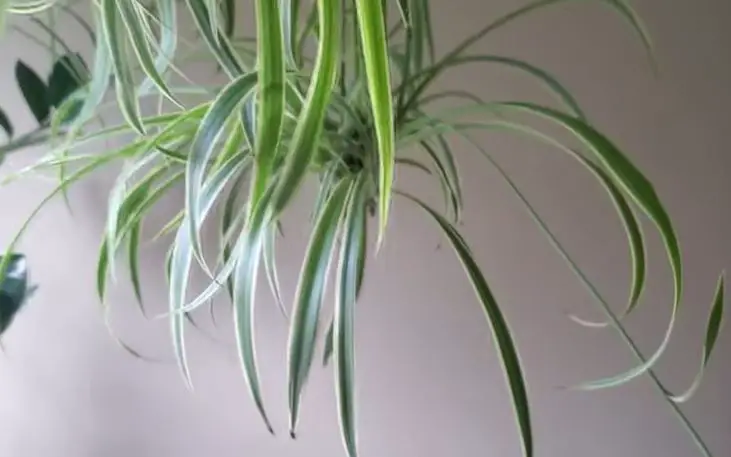Are you looking for a new plant addition for your garden? Look no further and opt for a spider plant. These pretty plants not only make a great visual addition to any garden but also are pretty versatile; interested? Continue reading and learn more about types of spider plants including, how to grow them and more.
If you are determined to grow a houseplant, you can’t go wrong with the famous spider plants. This group of plants is one of the most frequently seen in homes and offices all over the globe. And there’s good reason; spider plants can purify indoor air and remove 90% of airborne toxins. Not only that, the plant has lots of charm to fill up space in a room.
With that said, no matter how easy it is to care for a plant when you’re a first-timer, little research is always a good idea. And though it may seem a little intimidating, especially if you are new to growing your plants, you have nothing to worry about. With this guide, you’ll find out everything you need to know about types of spider plants.
Types of Spider Plants FAQ’s
How do I identify a spider plant?
The most common of all spider plants, the chlorophytum comosum ‘variegatum,’ has streaked leaves. The middle of each leaf is light yellow, while the outline is forest green.
Are there solid green spider plants?
Solid green spider plants occur naturally when plants revert to a parent plant. Variegation in plants is usually a genetic mutation. If your spider plant turns green, repot it into fresh soil and give it a dose of rooting fertilizer.
What is the best spider plant?
Vittatum is the most popular, evergreen, perennial spider plant variety. This ornamental plant has creamy and broad vertical stripes, slightly curved, medium green leaves. It can grow up to 1-2 feet long and wide. Grow this beautiful drought-tolerant hanging plant in well-drained soil under light shade.
What is the difference between an airplane plant and a spider plant?
Spider plant, also sometimes called airplane plant, is a houseplant that withstood the tests of time. Spider plant is typically grown in hanging baskets because of its gracefully arching leaves and stems that jet from the plant and carry baby plantlets on it.
How many types of spider plants are there?
The South African tropical rainforest houses around 65 different species of spider plants.
The different types of spider plants include bonnie, zebra, Hawaiian, capense, bichetii, reverse, and variegated spider plants. These varieties can be categorized into three groups: curly, variegated, and non-variegated spider plants.
- Curly spider plants. The curly type takes a lot from the variegated plant. The leaves look exactly like those of the variegated spider plant, except that they are curled. Its offspring also come out curled.
- Variegated spider plants. The variegated variety is the most popular. Although they are the easiest to find of the three, variegated spider plants may be quite eye-catching, especially if they have a lot of offshoots.
- Green (non-variegated) spider plants. It’s also known as “Shamrock.” Some people also call it “Ocean.” The solid green type is a rare variety that you won’t find easily in many of the nurseries. You might need to get it to form one of the online stores dealing with spider plants.
What are the most common types of spider plants?
Chlorophytum Comosum ‘Variegatum’ (Airplane Plant)
The most common of all spider plants, the middle of each leaf is light yellow while the outline is forest green. The plant has lots of charm to fill up space in a room. This variety of spider plants acts as the best air purifier.
Reverse Spider Plant
As the name implies, the outline and the middle of the leaves are the opposite of the variegatum. The outline of the leaves is a pale yellow, while the center is forest green.
Zebra Plant
The zebra spider plant looks quite like the ‘reverse variegatum’ but has a much brighter yellow outline on the leaves. This variety does not grow as tall as the others; instead, it grows wider rather than taller.
Bonnie Plant
This spider plant variety unfolds curly leaves and curly offspring. The bonnie spider plant looks much like a variegated spider plant but just curly.
Hawaiian spider plant
Also known as the Golden Glow, the Hawaiian Spider plant is simply fascinating and will give your room color with its glossy green leaves. This variety is small-sized and will not cover up much of your space.
Chlorophytum Capense
Also known as the bracket plant, this species is unique from the rest in that it doesn’t produce hanging offspring and has solid green leaves with a white edge.
Chlorophytum Bichetii
Chlorophytum Bichetii is a non-flowering chlorophytum species. These do not have any spiderette offshoots. This makes it ideal for ground covering rather than just being used as a hanging plant.
How to care for a spider plant?
- Sunlight. Although not picky with lighting, spider plants thrive best in bright light, as they are known for being window plants. Since they are not selective with their lighting choices, they will do just fine in partial direct sun conditions.
- Water. When you receive your new spider plant baby, water occasionally rather than weekly. The best rule of thumb is to let them fully dry out between waterings.
- Temperature: Spider plants like the sun, prefer cool temperatures ranging from 55-–5ºF. They are very much an indoor plant since they prefer cooler temperatures.
Do spider plants need to be repotted often?
Spider plants don’t need to be repotted often since much of their growth is through their leaves and plantlets. However, a sign that the spider plant needs to be repotted is if the root ball rises above the pot’s rim.
How to propagate spider plants?
All you need to do is pot the plantlets, which are easy to spot. The plantlets look similar to miniature versions of the spider plant. Regularly care for your newly potted plantlet to successfully propagate a spider plant.
How to avoid spider plants getting pests?
Spider plants are susceptible to some pest infestations. Aphids, mealybugs, Whitefield, and spider mites can eat your spider plant, but this can be avoided by misting your plants every once in a while. If the problem worsens, you may use natural insecticides made with vinegar to get rid of them.
Why do spider plants turn yellow?
Yellow leaves often mean there are excess minerals or fertilizer in the soil, meaning you may need to report the spider plant in more neutral ground. Leaves also turn yellow due to a lack of light.
What fertilizer should you use for spider plants?
All-purpose, complete, water-soluble, or granular time-release fertilizer is fitting for spider plants. Be cautious in over-fertilizing your plant, as the leaves will brown. Use fertilizer sparingly.
All-Purpose Organic Plant Food and Fertilizer
Indoor Plant Food and Garden Fertilizer. Compact and easy to store and use as often as every watering.
Just shake Joyful Dirt onto soil and water in or mix directly in a watering can. It is safe for pets and kids.
Enough for outdoor plants, but gentle enough to not burn indoor plants. Whether reviving plants or increasing foliage.

Features:
- Organic
- Easy application
- Safe
Types of Spider Plants
Reverse Variegated Spider Plant
The reverse variegated spider plants have leaves with white outer stripes and a green stripe between them.
Spider Plants make excellent house plants or indoor plants as they are not only such easy-growing plants but have beneficial properties in cleansing the air of pollutants, especially formaldehyde and carbon monoxide.
It tolerates artificial lighting very well and has air purifying abilities; it’s ideal in an office environment where electronic pollutants are emitted.
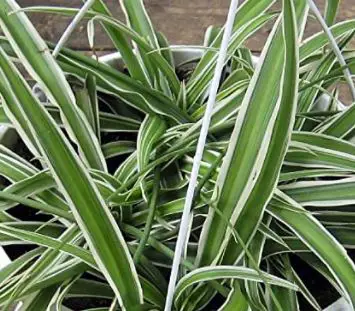
Features:
- Prefers bright, indirect light or artificial light
- Keep evenly moist, not wet or dry
Ocean Spider Plant
The ocean is a new spider plant with more white leaves and white flowers on long stems that seem to dance in the air.
Requires bright light or filtered sunlight for best growth and vibrant leaf colors. Never locate Spider Plants in full sun that will scorch their foliage.
Remove yellow or dried leaves to keep them tidy. Fertilize sparingly as excess nutrients can retard its ability to produce more plantlets.
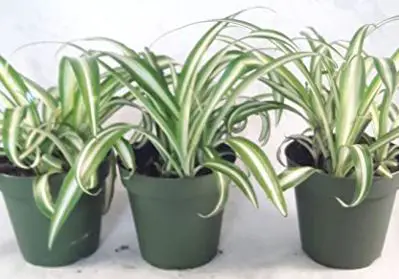
Features:
- Prefers bright, indirect light or artificial light
- Keep evenly moist, not wet or dry
- Three pack
Bonnie Curly Spider Plant
This plant comes fully rooted in a 4″ pot, ready to grow in your beautiful home or office.
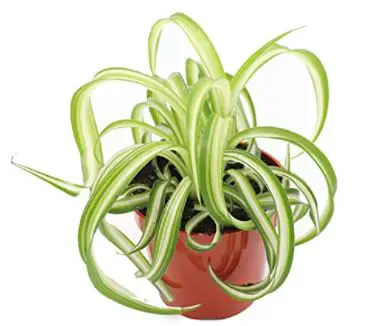
Features:
- Spider plant
- Enhance Your Environment
Hawaiian Spider Plant
One of the pretty new varieties of great-looking spider plants. Hawaiian spider, which is called, grows relatively compact with gorgeous green and creamy white broad foliage.
It needs moisture and bright light. The old growing rule calls for morning sun and afternoon shade. Should be moderately fed with 20-20-20 plant food.
Great for any place indoor or outdoor (in a mild climate).
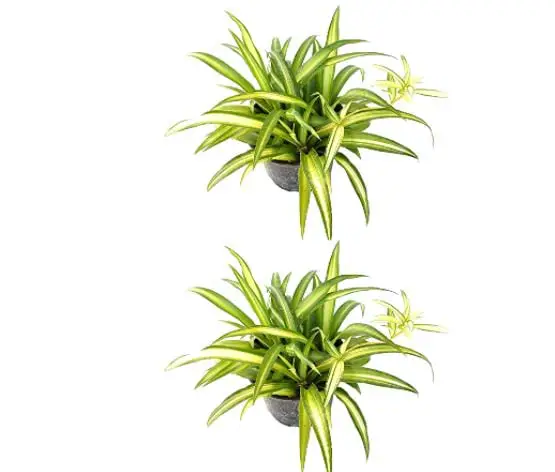
Features:
- Green-white
- Gorgeous foliage
- Air purifying plant

